A Glimpse Into The Amphibian World
First published in Sanctuary Asia,
Vol. 39
No. 10,
October 2019
Text and photographs by Dr. Seshadri K.S.
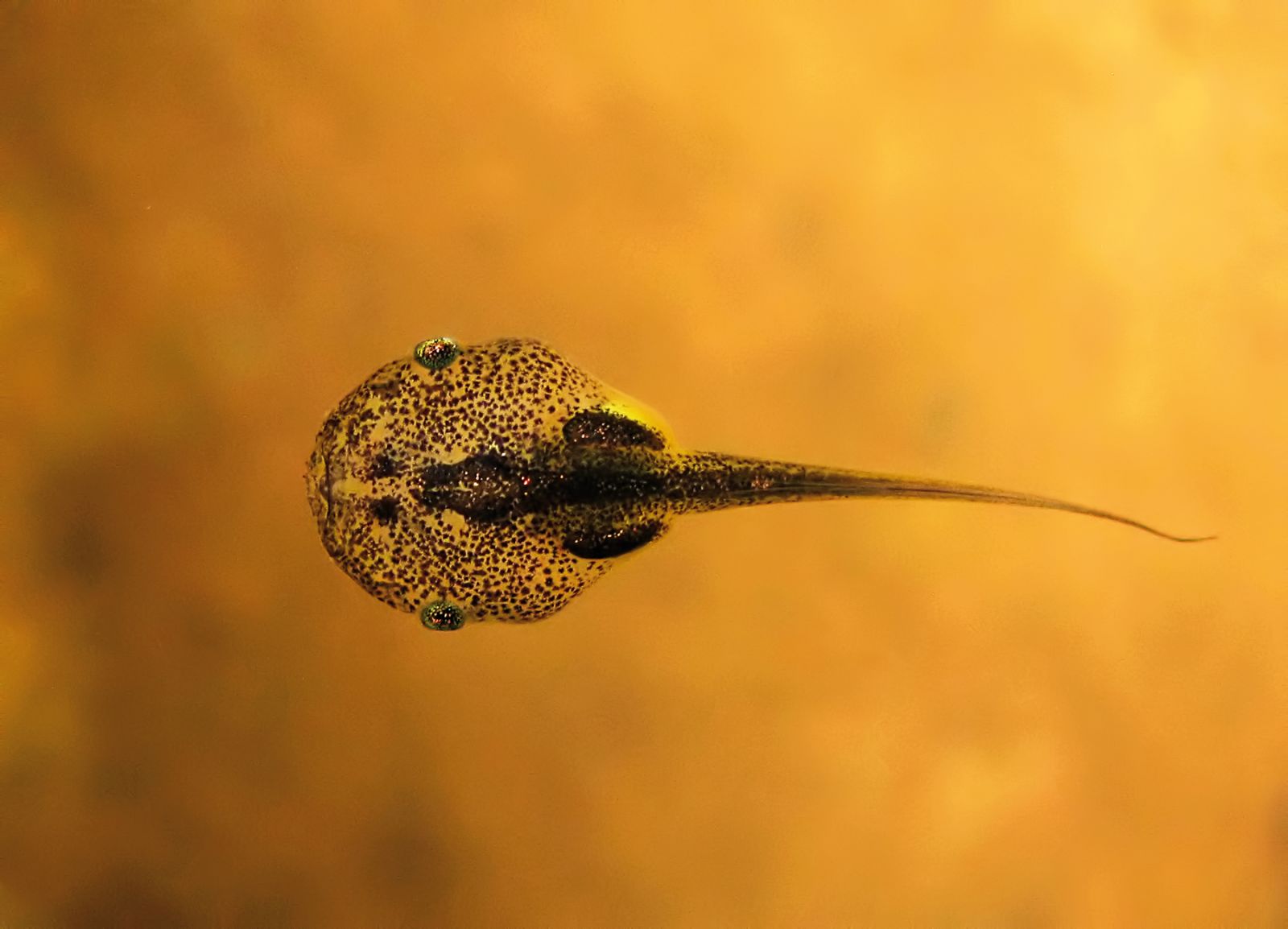
A tadpole of the Microhyla sp. in a pool of water in the Kathlekan region of Karnataka. Microhyla ornata tadpoles are especially sensitive to pollutants in the water.
“These foul and loathsome animals are abhorrent because of their cold body, pale colour, cartilaginous skeleton, filthy skin, fierce aspect, calculating eye, offensive smell, harsh voice, squalid habitation, and terrible venom...” wrote the Swedish naturalist, Carl Linnaeus in the 10th Volume of his magnum opus Systema Naturae, published in 1758. Over three centuries later, is our perception of amphibians any better? Unfortunately, amphibians continue to be largely held in contempt, eliciting responses such as ‘ewww’, ‘yuck’ and, rarely, ‘so cute’. A root cause for such disgust could be our bias and collective ignorance. Amphibians get their name from two Greek words, ‘amphi-’ and ‘-bios’ which indicate the dual lifestyle, typical of most amphibians wherein aquatic tadpoles/larvae metamorphose into terrestrial adults. Amphibians are distributed globally, except at the frozen poles, high-altitude mountain peaks, and dry deserts. They constitute three major groups: Anura (those lacking a tail), frogs and toads; Gymnophiona (those that possess a naked serpentine characteristic), caecilians and; Caudata (those with a prominent tail), salamanders and newts.
Primitive Origins
Amphibians are among the earliest vertebrates to have walked on land. They evolved from aquatic ancestors and colonised the earth around 360 million years ago (Mya). The earliest known ancestor to the modern-day frog is a fossil identified as Triadobatrachus massinoti, which roamed the earth during the early Triassic period, 250 Mya, in the landmass we now call Madagascar. The earliest caecilian ancestor does not show up in fossil records for until another 50 Mya, during the early Jurassic period (200-175 Mya). The caecilian Eocaecilia micropodia was discovered in present day Arizona. Another 50 million years elapsed until the earliest ancestor of salamanders appeared in fossil records during the late Jurassic period (157 Mya). It was dug up in present-day China and is known as Beiyanerpeton jianpingensis. During the subsequent millennia, several mass extinction events wiped out of a large number vertebrates and yet, some primitive amphibians survived, giving rise to modern-day amphibians. Among Anurans, species diversification is believed to have occurred most rapidly during the Cretaceous-Paleogene mass extinction event, which incidentally, wiped out non-avian dinosaurs around 66 Mya. Researchers postulate that there was an ‘ecological release’ wherein vegetation began to recover after a mass extinction and myriad frog species evolved rapidly to colonise the empty habitats. The fact that several arboreal frog lineages evolved around this time lends credence to this hypothesis.
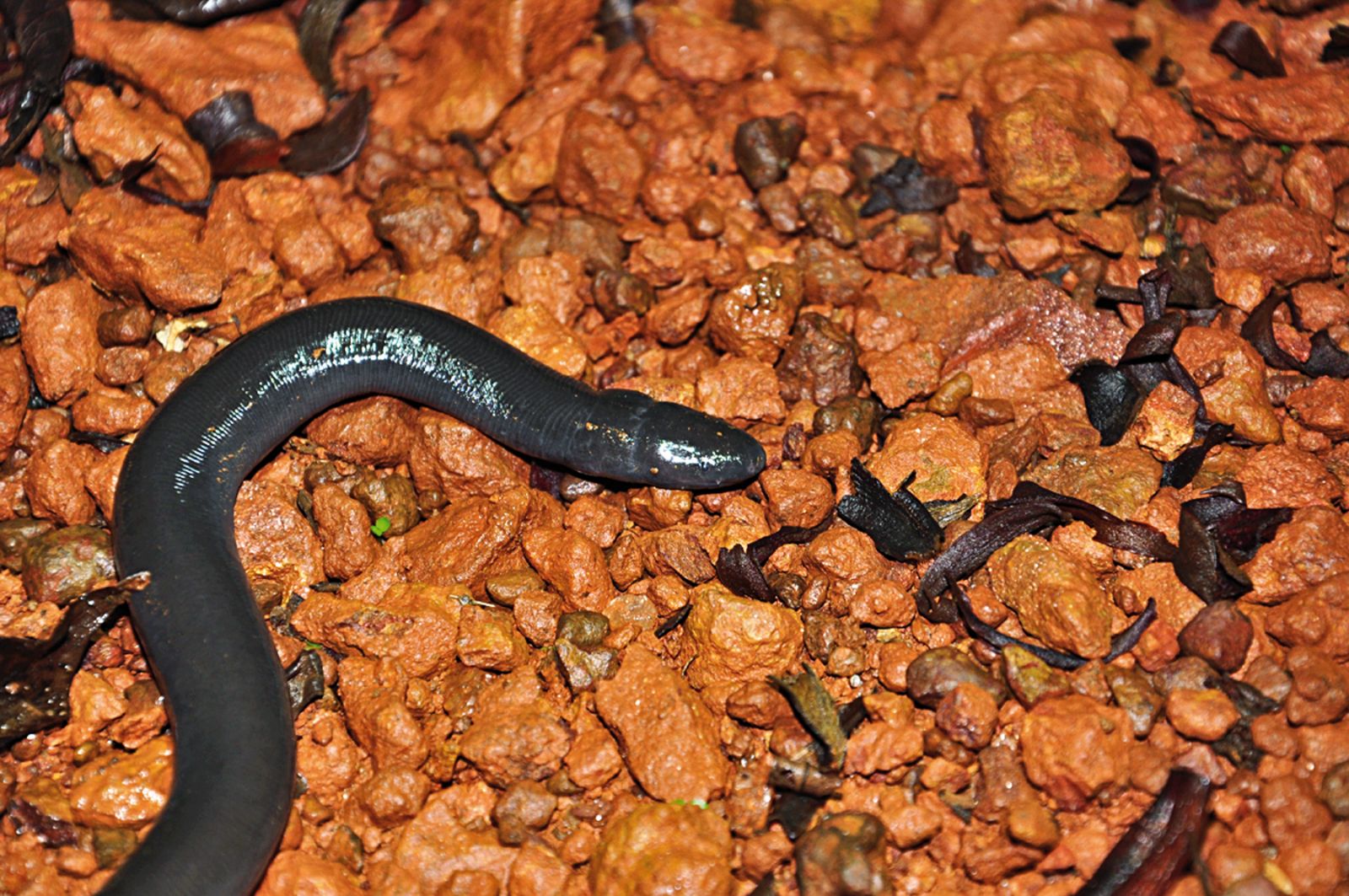
The caecilian Ichthyophis bombayensis, has distinct eyes surrounded by light rings, unlike most of its group, which are eyeless and thus blind.
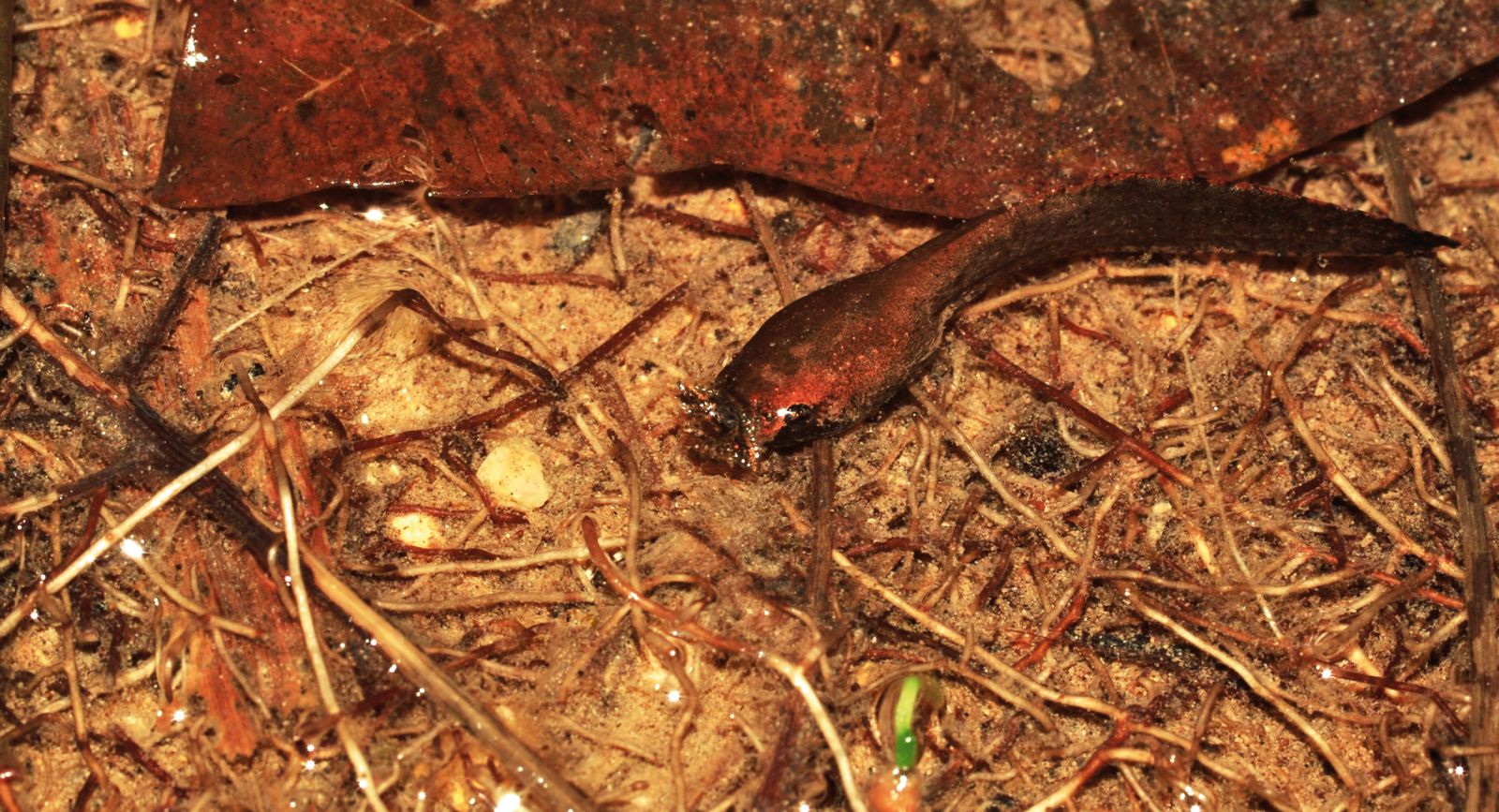
A tadpole of the Malayan horned frog Megophrys nasuta. The placement of the mouth reveals that the species is a surface feeder.
Astounding Diversity
Globally, there are approximately 8,074 species of amphibians with Anurans comprising 88 per cent (7,124 species), followed by Caudata (nine per cent, 737 species) and, Gymnophiona (three per cent, 213 species). Amphibian diversity is second only to birds (~9,000 species) and far greater than all mammals (~5,400 species). The smallest of them, a frog Paedophryne amauensis, is found in the remote jungles of Papua New Guinea. Measuring just short of eight millimetres from snout to vent, the frog is also considered to be the smallest vertebrate. The largest amphibian is the Chinese giant salamander Andrias davidianus. It often grows to lengths of up to 1.5 m. and can weigh up to 50 kg. Despite the stark contrast, all three groups of amphibians share several similarities but are distinct in appearance. A common characteristic of all amphibians is their semi-permeable moist skin, which helps them breathe. Another is the presence of antimicrobial peptides on their perpetually moist skin, which protects against infections. They also possess toxin-producing glands that shield them from predators.
The typical body plan of adult frogs and toads consists of a head, attached to the trunk without a neck; the trunk is small, with up to nine vertebrae and an elongated pelvic bone, giving them a sloping back. Their hind limbs are generally longer than forelimbs. They possess four fingers and five toes. They lack calcified teeth; some having toothed projections called ‘vomerine’ teeth. Many frogs and toads have a large tympanum used for hearing and males possess vocal sacs. Anurans have evolved incredible features that give them a curious agility. Their fingers and toes have segments, making them flexible and enabling them to hop long distances and climb slippery surfaces. Their ability to cling on to leaves is owed to adhesive disks on their digits. They are also able to effortlessly glide with the help of webbing between digits of hands and feet. Salamanders are lizard-like in appearance. The head is proportionate to the body and the tail is as long as the head and torso combined. The torso has up to 22 vertebrae and two pairs of legs of equal length with four fingers and five toes. When cornered by a predator, some salamanders cut off their tail, which wriggles around to distract the predator while the individual escapes and re-grows the tail. Caecilians are perhaps the most distinct of all amphibians. Lacking limbs, they look like large worms. Their cylindrical body is marked by annular rings and in most cases, has no distinct tail. The head is small and blunt and is the same diameter as the torso which has over 100 vertebrae. The head has a pair of eyes, which are reduced in size compared to the body. The mouth is large, containing several toothed projections and a pair of ‘tentacles’ on either side, located between the nostril and the jaw. It is a chemo-sensory organ, which can be flicked in and out, helping them sense their way underground. While most species are fossorial, a few are known to be aquatic. Our knowledge and understanding of amphibians are limited compared to that of other vertebrates. While frogs, toads, salamanders and newts are relatively well studied, very little is known about caecilians.
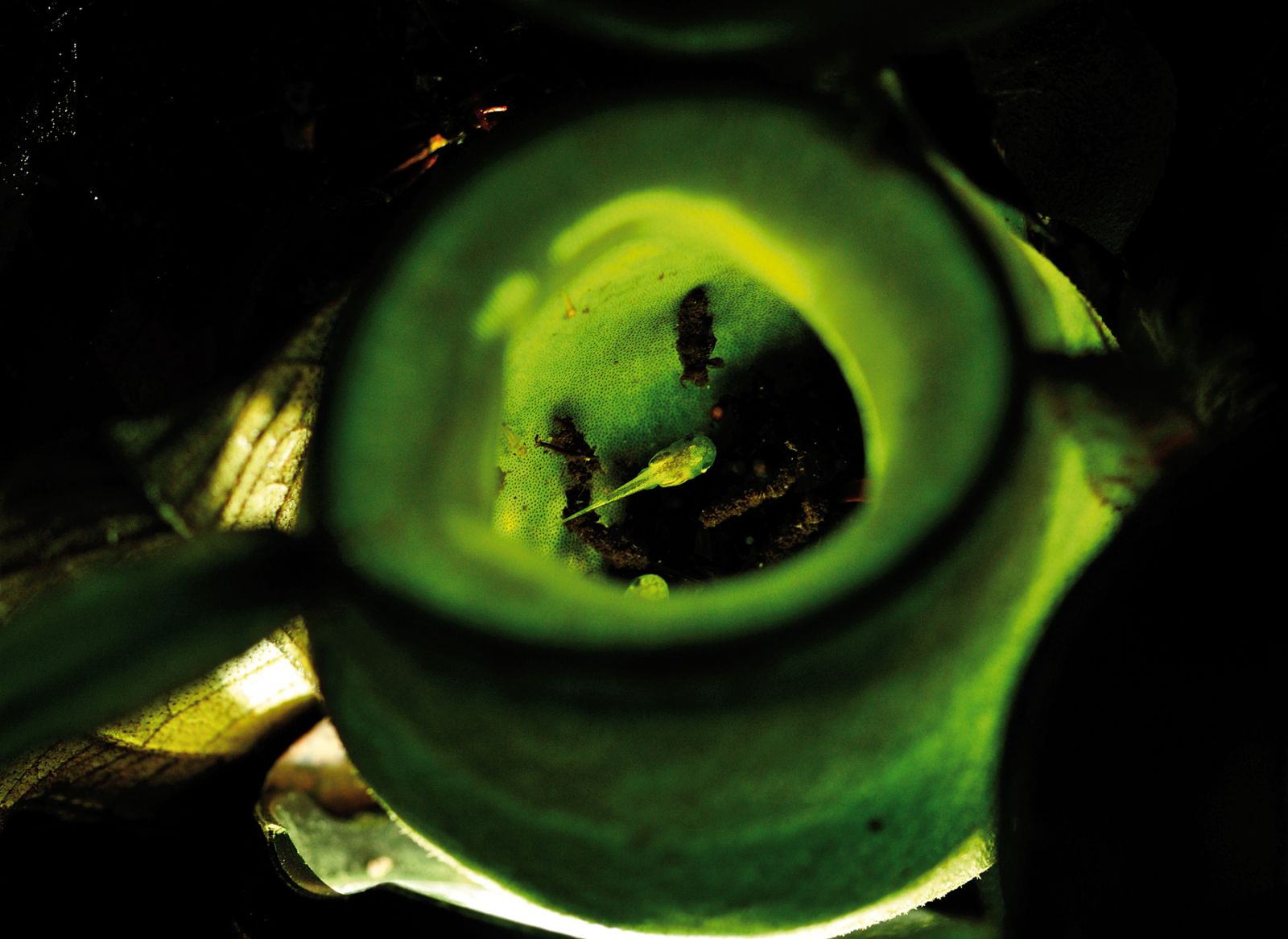
A Matang narrow-mouthed frog tadpole, Microhyla borneensis rests inside a pitcher plant, apparently immune to the liquid it produces to dissolve insects.
The Great Colonisers
The three groups are distributed in remarkably different ways: Anurans are widespread, decreasing in diversity towards the north pole and increasing towards the south pole, but absent at both poles. Their greatest diversity is present at the equator and around the tropics; salamanders are predominant in the northern hemisphere with a few species reaching south of the equator in South America and; Caecilians are restricted to the equator. Specifically, most Anuran species are found in the lowland rainforests of South America, Central Africa, Madagascar, Western Ghats of India, Southeast Asia, Oceania and Eastern Australia. Salamanders thrive most on the West Coast, in the Eastern United States, Europe, and parts of Asia. Caecilians are predominant in the lowland rainforests of South America, the Ivory Coast in Africa, the Western Ghats of India and across Southeast Asia. This disjunctive distribution is probably a synergistic result of their historical origins, continental drift, ecology and present-day climate. Understanding the distribution pattern of amphibians, however, continues to be an unresolved puzzle in biogeography. Even regionally, the distribution of amphibians varies. For example, amphibiaweb.org lists 435 species found India, with 394 frogs and toads, 39 caecilians and two salamanders. Over 80 per cent of these species are endemic to the Western Ghats and both salamanders are endemic to the Himalaya. In India, there are three global biodiversity hotspots; the Western Ghats, northeast India and the Andaman Islands. Incidentally, each of these areas is renowned for endemic amphibians.
Hidden in Plain Sight – Euphlyctis karaavali and Microhyla laterite
Two species of frogs were discovered on the outskirts of the Western Ghats in the midst of human settlements in 2016. Both were likely confused to be their close relatives who are common and widespread. In the town of Manipal near Udupi in Karnataka, Ramit Singal, an engineer by training, encountered a frog belonging to the genus Microhyla. A few hundred kilometres away, C.R. Naik, a forester encountered another frog and asked us to identify it. We listened to the call and brushed it off as the call of a White-throated Kingfisher. He persisted and got a video the next night and we were spellbound; it was a skittering frog of the genus Euphlyctis. Using the call, morphology and genetic samples, we were able to determine that they were indeed different species and named one as Microhyla laterite after the fast disappearing laterite rock formations and the other as Euphlyctis karaavali after the Kannada name for the coastal region where the frog was restricted. Both the species are already threatened by rampant habitat loss. The discoveries highlight the fact that one only needs to pay careful attention to what is around them and many species may be waiting to be discovered.
.jpg)
Euphlyctis karaavali
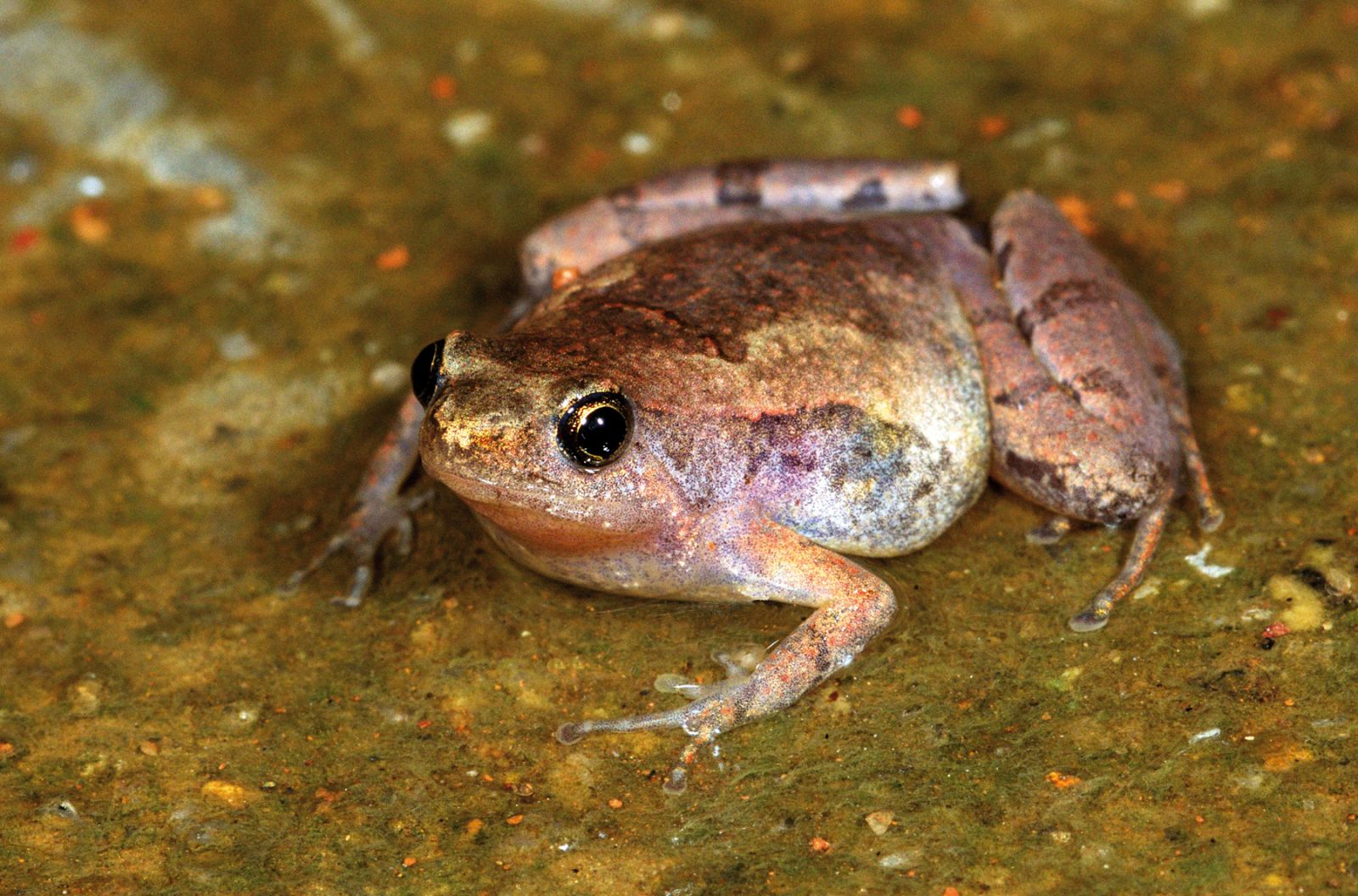
Microhyla laterite
Exceptional Ecology
Amphibians are an important component of the ecosystem. They primarily feed on invertebrates such as insects, many of which we consider to be pests and unbeknown to us, keep their population under check. Being primary consumers, they are an important source of nutrition to other organisms in the food chain. Amphibians are consumed by predators such as birds, snakes and, small mammals. It is very likely that in any given area, the highest numbers of vertebrates excluding humans are going to be amphibians because of their abundance and commonness – they are found right in the middle of cities to remote jungles even on far-flung islands.
It is likely that the most common encounter of amphibians to most of us is the incessant chorus of frogs on a rainy night. Anurans communicate primarily by sound, where the males call to attract the females. Salamanders and caecilians communicate with chemical cues. The reproductive behaviour of amphibians is one of the most intricate aspects of amphibian biology. They evolved from aquatic ancestors and despite having colonised terrestrial habitats, they seem unable to break their connection with water as many of them return to water to breed. Several groups of frogs have indeed been able to move away from water that they no longer require any free-flowing water to breed. Such an adaptation is called ‘Direct Development’ which has so far been observed in over half of all amphibians. In this adaptation, amphibians deposit eggs in terrestrial habitats such as in moss, on leaves or under leaf litter. The embryo develops within the translucent eggs and a juvenile amphibian emerges. In the Western Ghats for example, all species of the genus Raorchestes are believed to undergo direct development and some, like the bamboo breeding frog Raorchestes chalazodes provide intensive parental care to the offspring (Sanctuary Asia Vol. 38, No. 12, December 2018). The diversity of reproductive behaviour of amphibians brings into question the validity of the notion of ‘dual life’ upon which amphibians are classified. There are thousands of species for which the traditional egg to tadpole to adult transformation is not the norm and as we learn more, we realise that exceptions are in fact, a rule in biology.
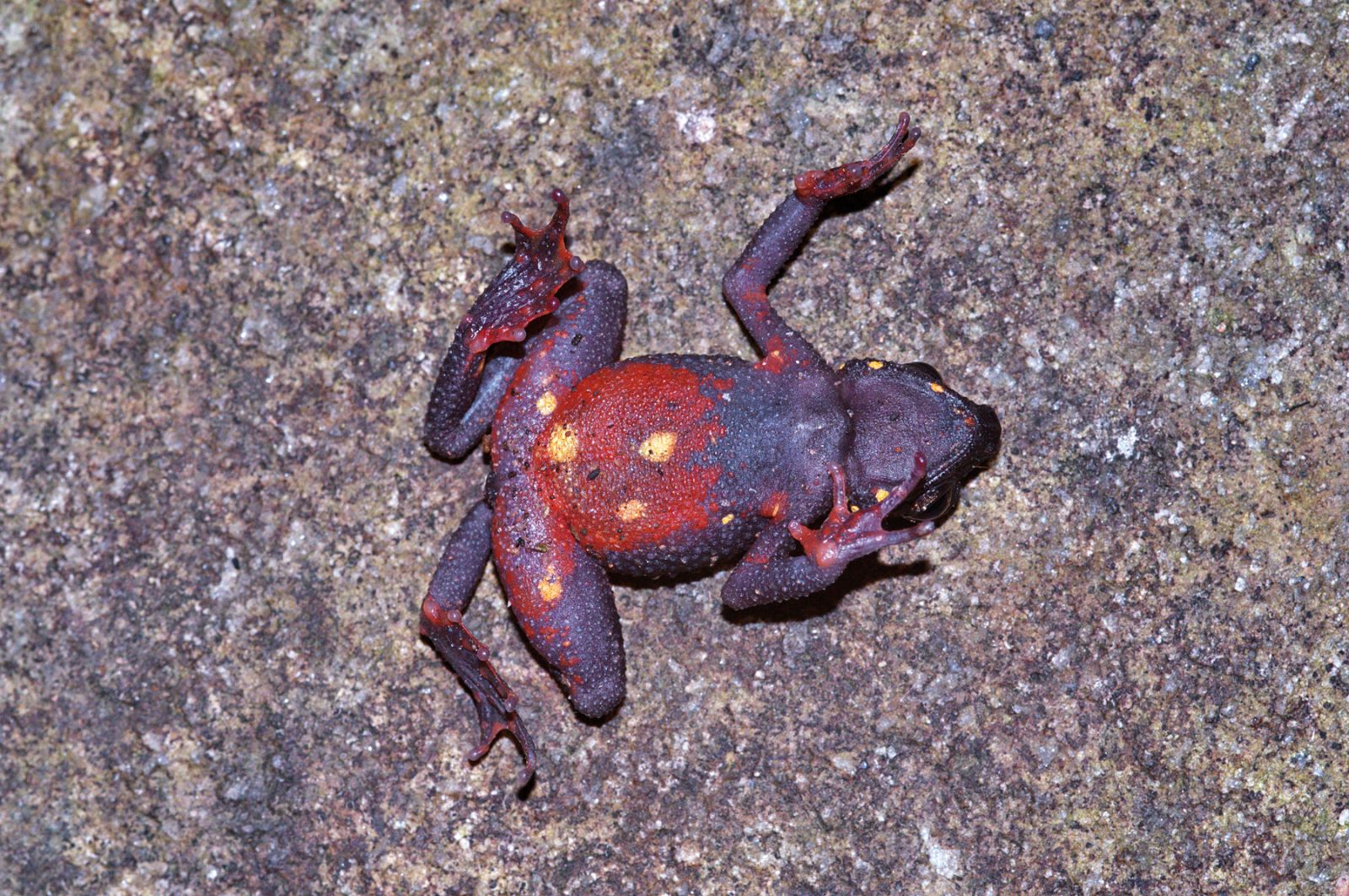
Some frogs, such as this adult Ghatophryne ornata, often flip over to play dead to startle predators by displaying their vibrantly coloured underbelly. This behaviour is called the Unken Reflex.
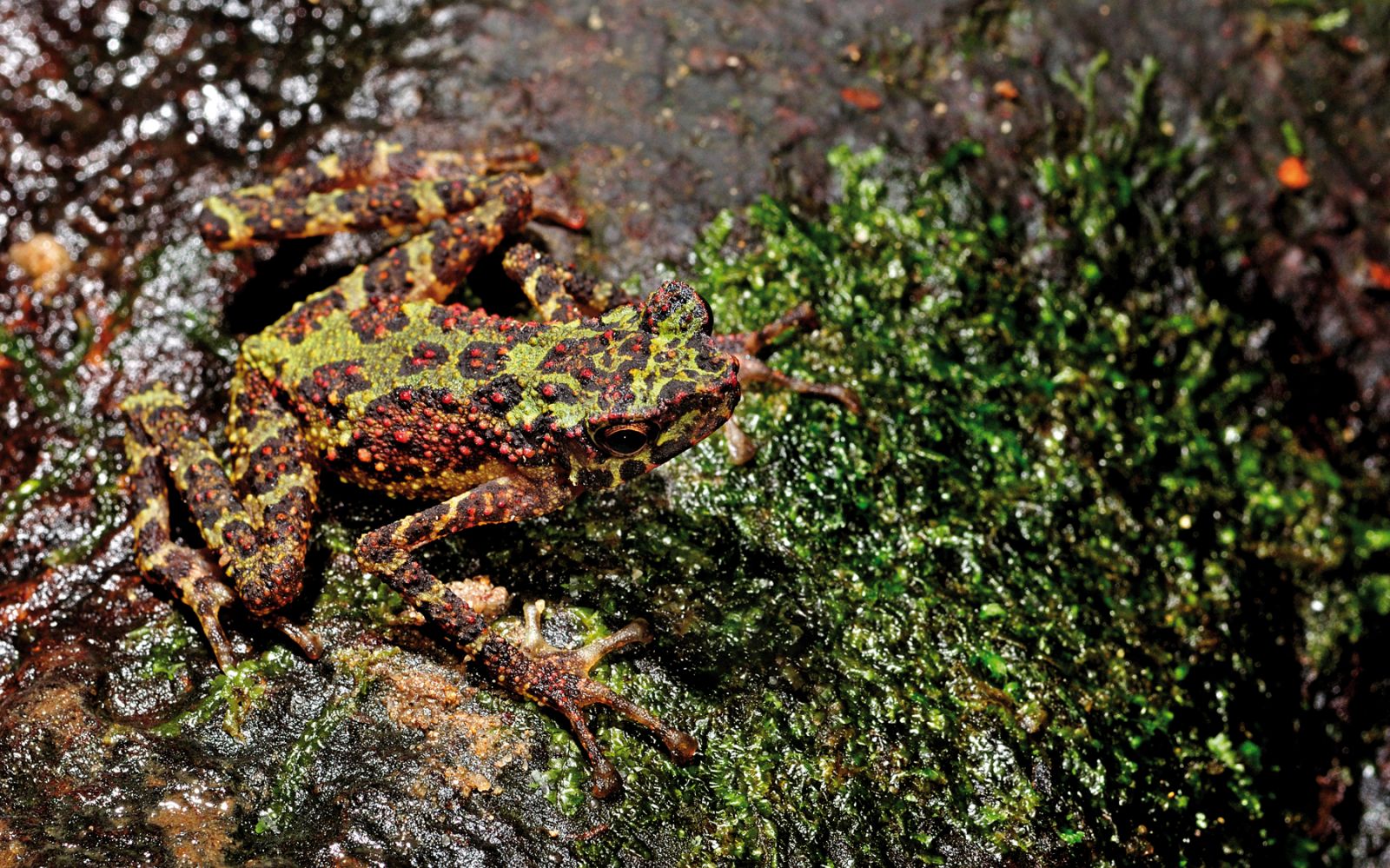
The rainbow toad Ansonia latidisca, spotted in Sarawak, Borneo in 2011 for the first time in nearly a century.
Roads, Roadkills and Barriers to Movement
India has one of the highest density of roads and other linear intrusions in the world, second only to the United States. Roads, railway lines and power lines continue to bisect natural habitats. Amphibians move to and away from breeding resources such as streams and ponds. They often get crushed by speeding vehicles when they have to cross a road. Several thousand gravid female frogs and Caecilians get run over by vehicles annually. Roads are also barriers for dispersal. For example, the tadpoles of an endemic genus of frogs Indirana breed in a thin film of flowing water over rocks and boulders. The tadpoles develop hind legs first and hop out, moving terrestrially. Road surfaces alter the natural flow of water, increase water depth in puddles along the road and prevent the movement of tiny tadpoles. The tadpoles are thus unable to disperse and risk facing immense competition for resources. Lack of dispersal affects gene flow and as a result, populations are at risk of local extinction. Stopping night time traffic on roads through sensitive areas, preventing road expansion, creating underpasses for movement of frogs and educating motorists are some options to reduce the impact of roads on amphibians.
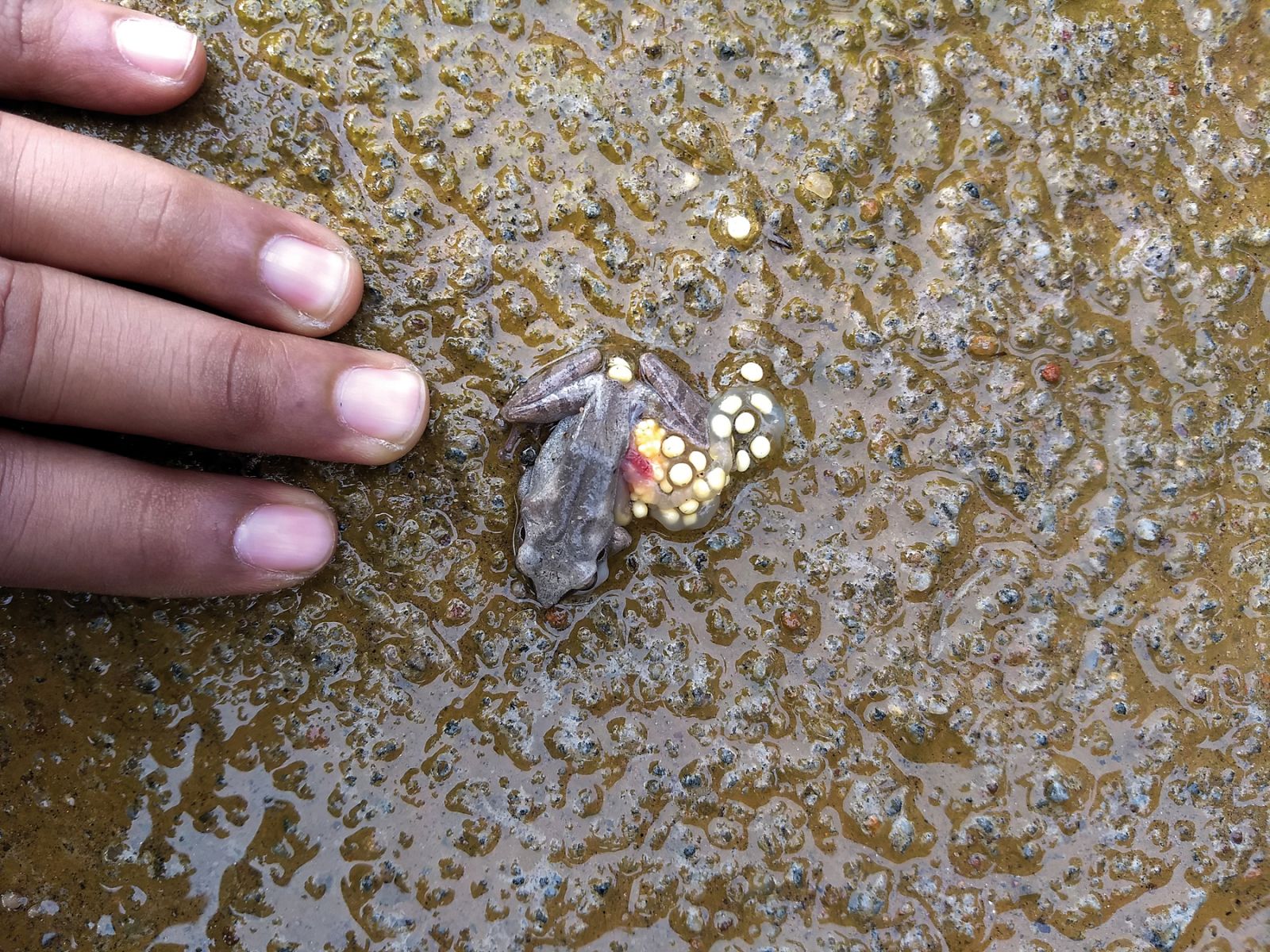
A road-kill of a gravid female Amboli bush frog, Pseudophilautus amboli.
In Dire Straits
Over the last decade, there has been a sharp increase in the discovery of amphibians globally. In India alone, over 150 species of amphibians have been described from the year 2010 onwards at the rate of nearly three species every week. While some of these discoveries are a result of stabilising taxonomy and separating cryptic species lumped into one group; many are discoveries of frogs that had been ‘hidden’ in plain sight! (read Hidden in Plain Sight below). Despite these discoveries, the amount of knowledge of each species continues to remain inadequate. According to the IUCN Red List assessment made in 2004, the populations of 43 per cent of amphibians were on the decline and seven per cent of amphibians faced the risk of extinction. The threat status of nearly 5,800 species was left out because there was so little information about them. Subsequent studies using statistical approaches predict that over half of the amphibians in the ‘Not Assessed’ category would likely be ‘Critically Endangered’ when formally assessed.
Amphibians are sensitive to environmental changes and are reeling under pressures created by anthropogenic activities, which result in perturbations to habitat, temperature regime and rainfall. The indiscriminate use of pesticides, increasing UV-B radiation, spreading of infectious diseases and, expanding linear intrusions (read Roads, Roadkills and Barriers to Movement below) have deepened the impact. These perturbations have synergistic lethal effects. Several amphibians such as the Chinese giant salamander are extremely rare in the wild because they are a local delicacy and are thus hunted. With constant changes in global climate, frogs are certainly affected. On comparing measurements of museum specimens over time, researchers have found that increasing global temperatures have led to a reduction in the body size of frogs. Such impacts will have devastating cascading effects on the ecosystem.
One of the most widespread threats to amphibian populations is the deadly fungal disease Chytridiomycosis, caused by the fungus Batrachochytrium dendrobatidis. The fungal spores spread through the environment and cause lesions on Anurans and they eventually die of heart failure. Two species of Australian gastric-brooding frogs went extinct in the 1980s. The Panamanian golden frog Atelopus zeteki nearly went extinct in the wild in 2007. In both cases, it was the fungal disease, which posed a threat. Recent genetic studies have revealed that the fungus originated in East Asia and spread to other parts of the world, likely via the illegal pet trade. Native frogs are resistant to the local strain, but not to the alien strain. So far, the only effective measure against this deadly pathogen is to not handle frogs, wash all field gear in potassium permanganate solution and in extreme cases, transfer the entire population to a captive breeding facility and re-introduce them once a solution to control the pathogen has been figured out. Unfortunately, a new species of the deadly fungus, B. salamandrivorans was discovered recently in salamanders. As yet, it only affects salamanders and is restricted to a small part of Europe where it will likely remain contained. One thing that's certain however, is that the future of amphibians is uncertain.
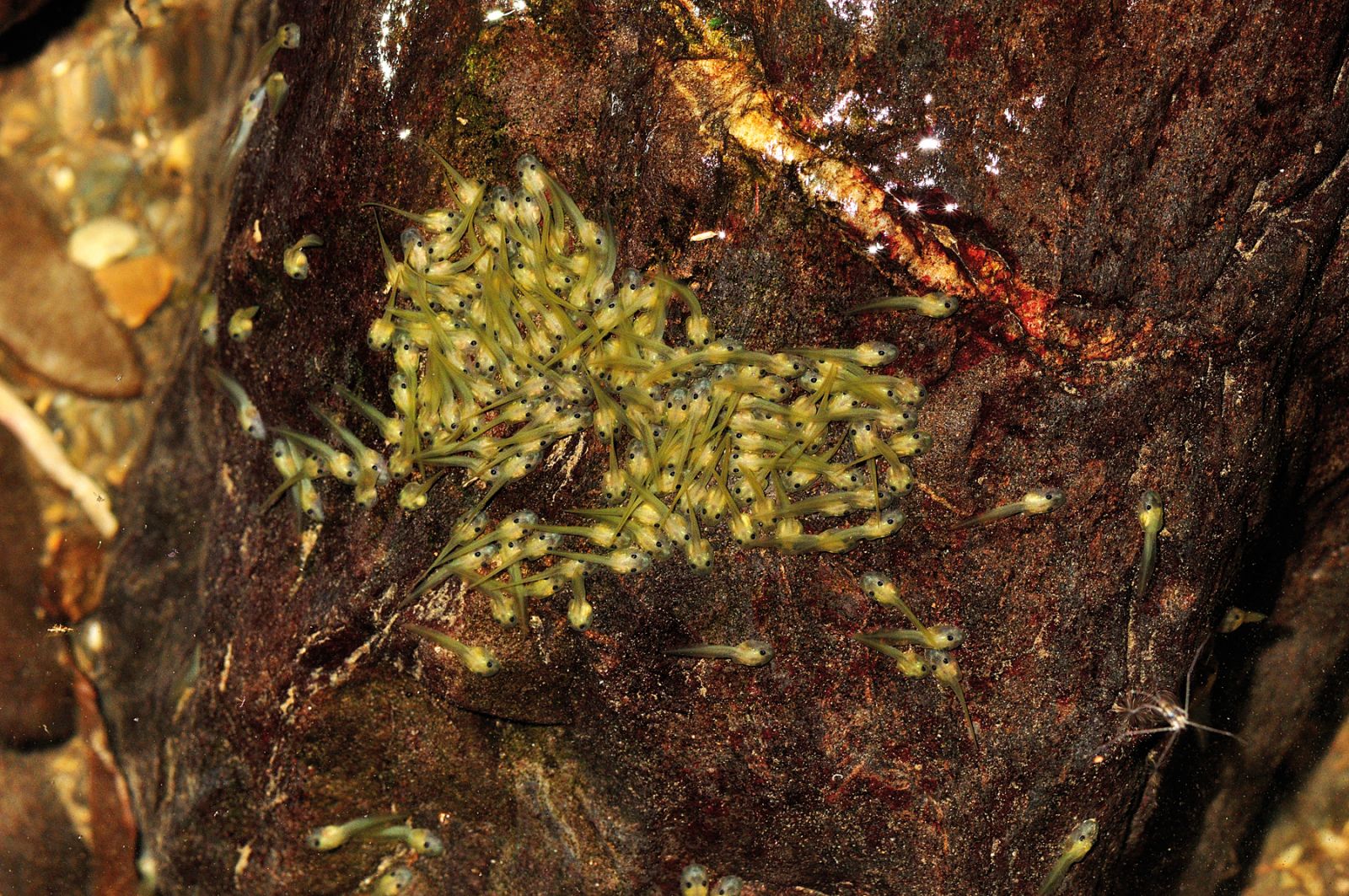
In the crystal clear waters of the Kinabalu Mountains of Borneo, we see a brightly-coloured cluster of Meristogenys kinabaluensis tadpoles.
A Lost Cause?
One would find it ironic that amphibians that survived several mass extinctions during their 360 Mya journey into the present are going extinct today. Amphibians are important culturally — there are references to them in the Rig Vedas and proverbs, they provide us with the free service of pest control and are aesthetically pleasing. Conserving them is certainly not a lost cause and the first step is to increase awareness of people and acknowledge that there is a problem.
We are currently in the midst of a sixth mass extinction and the time period following the 20th century is known as the Anthropocene, the era of human domination. We have the power to change things, for the worse or for the better. Participating in educational programmes cutting across age groups (see box on this page); producing accessible field guides, especially in local languages; collecting long term ecological data to detect population fluctuations; saying no to frog delicacies; not handling them for photography; lobbying for habitat protection; and creating frog-friendly habitats outside of national parks and sanctuaries are some of the ways in which we could help make a better world for amphibians. This is an excellent opportunity to change Linnaeus’s perception that amphibians are foul and loathsome creatures. In fact, they are everything but that. We ought to let them hop, walk or crawl a little bit closer into our hearts to ensure their survival.
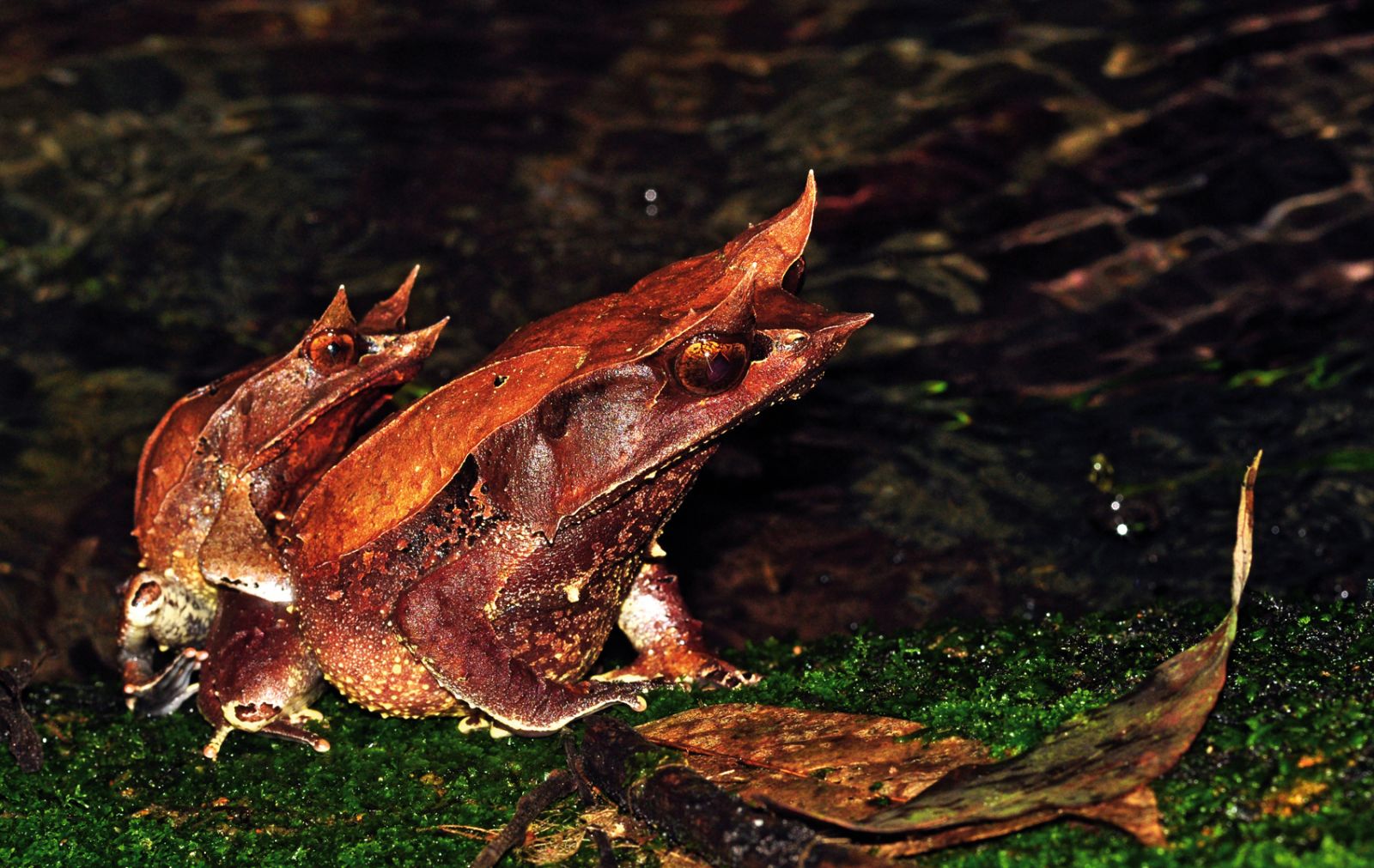
This fierce-looking pair in amplexus (mating position) are Malayan horned frogs Megophrys nasuta. As with most frogs, males are much smaller in size than females whose backs they mount as the latter go in search of suitable spots to lay their eggs.
Frog-watching
With the advent of cameras, we live in a world of shoot first and ask later! While there is nothing wrong with it, photographs can be misleading to identify amphibians. Detailed notes are indispensable as they bring us closer to the organism we are observing. How does one go about watching frogs? To encourage frog enthusiasts, my colleagues and I have been involved in various efforts to popularise frog-watching. Watching amphibians is similar to watching birds. First, we locate them either by movement or by its call. Then, we carefully observe its features, make a field sketch, take detailed notes and refer to field guides. There are several workshops on amphibians that are held across India; these are typically open to anyone and charge a nominal fee. The Bisle Frog-Watch, started by a group of nature enthusiasts is one such opportunity. Every monsoon, about 30 people gather in the sleepy town of Bisle in Karnataka to learn about amphibians. Classroom sessions are followed by field sessions. Cameras and handling of any frogs are strictly prohibited. Participants make detailed sketches, which we use for identification with the help of field guides and taxonomic descriptions. The seventh annual Bisle Frog-Watch was held in July this year. A parallel initiative is underway at the Agumbe Rainforest Research Station in Agumbe.






.jpg)





